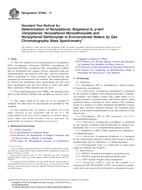Potrebujeme váš súhlas na využitie jednotlivých dát, aby sa vám okrem iného mohli ukazovať informácie týkajúce sa vašich záujmov. Súhlas udelíte kliknutím na tlačidlo „OK“.
ASTM D7065-11
Standard Test Method for Determination of Nonylphenol, Bisphenol A, p-tert -Octylphenol, Nonylphenol Monoethoxylate and Nonylphenol Diethoxylate in Environmental Waters by Gas Chromatography Mass Spectrometry
Automaticky preložený názov:
Štandardná skúšobná metóda pre stanovenie nonylfenol, bisfenol A, p-terc -Octylphenol nonylfenolu Monoethoxylate a nonylfenol Diethoxylate vo vodách v oblasti životného prostredia pomocou plynovej chromatografie hmotnostnej spektrometrie
NORMA vydaná dňa 15.6.2011
Informácie o norme:
Označenie normy: ASTM D7065-11
Poznámka: NEPLATNÁ
Dátum vydania normy: 15.6.2011
Kód tovaru: NS-37469
Počet strán: 13
Približná hmotnosť: 39 g (0.09 libier)
Krajina: Americká technická norma
Kategória: Technické normy ASTM
Kategórie - podobné normy:
Anotácia textu normy ASTM D7065-11 :
Keywords:
bisphenol A, continuous liquid-liquid extraction, diethoxylate, ethoxylate, gas chromatography, mass spectrometry, monoethoxylate, Nonylphenol, octylphenol, water, ICS Number Code 71.080.15 (Aromatic hydrocarbons)
Doplňujúce informácie
| Significance and Use | ||
|
5.1 Nonylphenol3, octylphenol, and bisphenol A have been shown to have toxic effects in aquatic organisms. The source of nonylphenol and octylphenol is prominently from the use of common commercial surfactants. The most widely used surfactant is NPEO which has an average ethoxylate chain of 9 mol of ethoxylate. The ethoxylate chain is readily biodegraded to form NP1EO and NP2EO, nonylphenol carboxylate (NPEC) and, under anaerobic conditions, nonylphenol. Nonylphenol will also biodegrade, but may be released into environmental waters directly at trace levels. This method has been investigated for use with surface water and waste treatment effluent samples and is applicable to these matrices. It has not been investigated for use with salt water or solid sample matrices. 5.2 The first reported synthesis of BPA was by the reaction of phenol with acetone by Zincke.1.1 This test method covers determination of nonylphenol (NP), nonylphenol ethoxylate (NP1EO), nonylphenol diethoxylate (NP2EO), octylphenol (OP), and bisphenol A (BPA) that are partitioned into organic solvent, separated using gas chromatography and detected with mass selective detection. These compounds or isomer mixtures are qualitatively and quantitatively determined by this method. This method adheres to selected ion monitoring mass spectrometry but full scan mass spectrometry has also been shown to work well under these conditions. Either analysis may be used. 1.2 The method detection limit (MDL) and reporting limit (RL) for NP, NP1EO, NP2EO, OP, and BPA are listed in Analyte |
MDLA, (μg/L) |
Reporting RangeB (μg/L) |
|
NP |
0.9 |
5.0-80.0 |
|
NP1EO |
1.2 |
10.0-160.0 |
|
NP2EO |
1.8 |
20.0-320.0 |
|
OP |
0.2 |
1.0-16.0 |
|
BPA |
0.3 |
1.0-16.0 |
1.4 This standard does not purport to address all of the safety concerns, if any, associated with its use. It is the responsibility of the user of this standard to establish appropriate safety and health practices and to determine the applicability of regulatory limitations prior to use.
|
Standard Practice for the Preparation of Substitute Wastewater |
|
|
Standard Practice for Writing Quality Control Specifications for Standard Test Methods for Water Analysis |
|
|
Standard Guide for Management Systems in Laboratories Engaged in Analysis of Water |
|
|
Standard Practices for Preparation of Sample Containers and for Preservation of Organic Constituents |
|
|
Standard Specification for Reagent Water |
|
|
Standard Practice for Conducting an Interlaboratory Study to Determine the Precision of a Test Method |




 Cookies
Cookies
